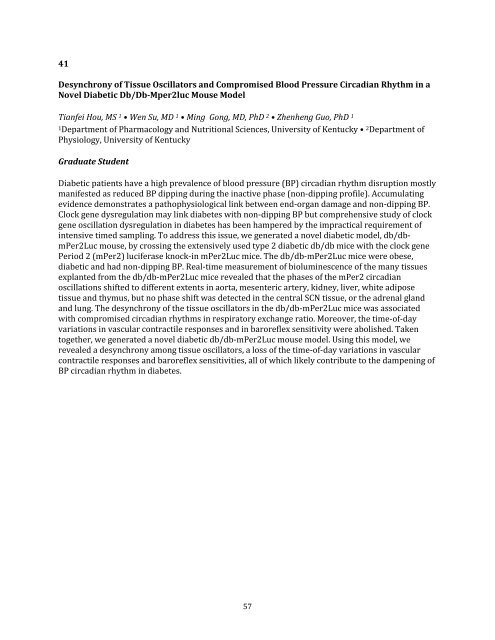2017 Cardiovascular Research Day Abstract Book
You also want an ePaper? Increase the reach of your titles
YUMPU automatically turns print PDFs into web optimized ePapers that Google loves.
41<br />
Desynchrony of Tissue Oscillators and Compromised Blood Pressure Circadian Rhythm in a<br />
Novel Diabetic Db/Db-Mper2luc Mouse Model<br />
Tianfei Hou, MS 1 • Wen Su, MD 1 • Ming Gong, MD, PhD 2 • Zhenheng Guo, PhD 1<br />
1Department of Pharmacology and Nutritional Sciences, University of Kentucky • 2 Department of<br />
Physiology, University of Kentucky<br />
Graduate Student<br />
Diabetic patients have a high prevalence of blood pressure (BP) circadian rhythm disruption mostly<br />
manifested as reduced BP dipping during the inactive phase (non-dipping profile). Accumulating<br />
evidence demonstrates a pathophysiological link between end-organ damage and non-dipping BP.<br />
Clock gene dysregulation may link diabetes with non-dipping BP but comprehensive study of clock<br />
gene oscillation dysregulation in diabetes has been hampered by the impractical requirement of<br />
intensive timed sampling. To address this issue, we generated a novel diabetic model, db/dbmPer2Luc<br />
mouse, by crossing the extensively used type 2 diabetic db/db mice with the clock gene<br />
Period 2 (mPer2) luciferase knock-in mPer2Luc mice. The db/db-mPer2Luc mice were obese,<br />
diabetic and had non-dipping BP. Real-time measurement of bioluminescence of the many tissues<br />
explanted from the db/db-mPer2Luc mice revealed that the phases of the mPer2 circadian<br />
oscillations shifted to different extents in aorta, mesenteric artery, kidney, liver, white adipose<br />
tissue and thymus, but no phase shift was detected in the central SCN tissue, or the adrenal gland<br />
and lung. The desynchrony of the tissue oscillators in the db/db-mPer2Luc mice was associated<br />
with compromised circadian rhythms in respiratory exchange ratio. Moreover, the time-of-day<br />
variations in vascular contractile responses and in baroreflex sensitivity were abolished. Taken<br />
together, we generated a novel diabetic db/db-mPer2Luc mouse model. Using this model, we<br />
revealed a desynchrony among tissue oscillators, a loss of the time-of-day variations in vascular<br />
contractile responses and baroreflex sensitivities, all of which likely contribute to the dampening of<br />
BP circadian rhythm in diabetes.<br />
57


